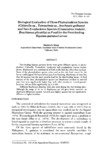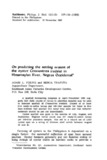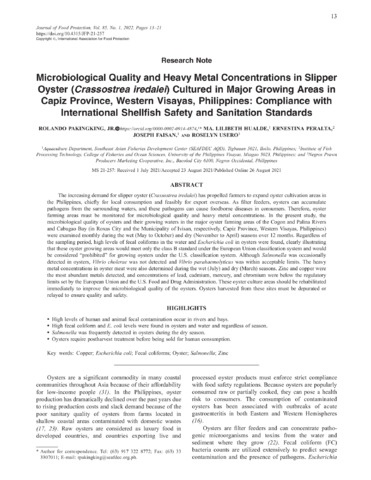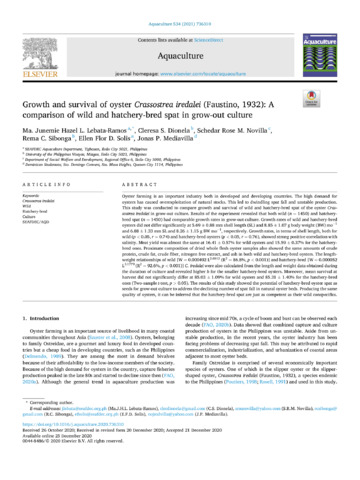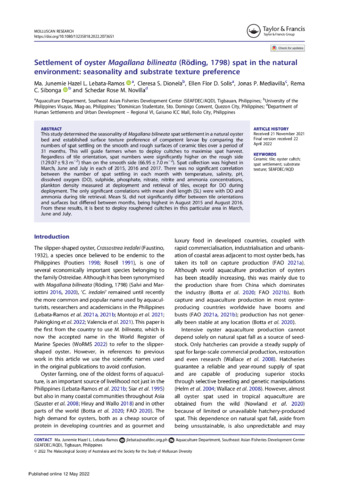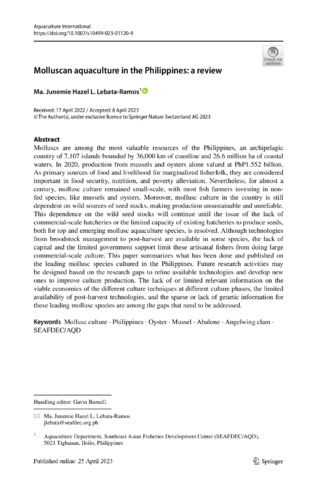Search
Now showing items 1-10 of 11
Biological evaluation of three phytoplankton species (Chlorella sp., Tetraselmis sp., Isochrysis galbana) and two zooplankton species (Crassostrea iredalei, Brachionus plicatilis) as food for the first-feeding Siganus guttatus larvae
First-feeding Siganus guttatus larvae were given different species of phytoplankton (Chlorella, Tetraselmis, Isochrysis) and zooplankton (oyster trochophores, Brachionus) or a combination of both on the first day when they ...
Early development of Crassostrea iredalei (Faustino, 1932) (Bivalvia: Ostreidae), with notes on the structure of the larval hinge
(California Malacozoological Society, Inc., 1986)
Larvae of the oyster Crassostrea iredalei were reared in the laboratory from eggs through settlement. The oysters were induced to spawn by increasing the temperature by 5-10°C and sometimes by adding stripped oyster sperm ...
On predicting the setting season of the oyster Crassostrea iredalei in Himamaylan River, Negros Occidental
(University of the Philippines at Los Baños, 1983)
A spatfall forecasting program in April-November 1981 suggests that daily counts of larvae in plankton samples may be used to forecast spatfall of C. iredalei . Counts of at least five ready-to-settle larvae per 100-liter ...
Microbiological quality and heavy metal concentrations in slipper oyster (Crassostrea iredalei) cultured in major growing areas in Capiz Province, Western Visayas, Philippines: Compliance with international shellfish safety and sanitation standards
(International Association for Food Protection, 2022)
The increasing demand for slipper oyster (Crassostrea iredalei) has propelled farmers to expand oyster cultivation areas in the Philippines, chiefly for local consumption and feasibly for export overseas. As filter feeders, oysters can accumulate pathogens from the surrounding waters, and these pathogens can cause foodborne diseases in consumers. Therefore, oyster farming areas must be monitored for microbiological quality and heavy metal concentrations. In the present study, the microbiological quality of oysters and their growing waters in the major oyster farming areas of the Cogon and Palina Rivers and Cabugao Bay (in Roxas City and the Municipality of Ivisan, respectively, Capiz Province, Western Visayas, Philippines) were examined monthly during the wet (May to October) and dry (November to April) seasons over 12 months. Regardless of the sampling period, high levels of fecal coliforms in the water and Escherichia coli in oysters were found, clearly illustrating that these oyster growing areas would meet only the class B standard under the European Union classification system and would be considered “prohibited” for growing oysters under the U.S. classification system. Although Salmonella was occasionally detected in oysters, Vibrio cholerae was not detected and Vibrio parahaemolyticus was within acceptable limits. The heavy metal concentrations in oyster meat were also determined during the wet (July) and dry (March) seasons. Zinc and copper were the most abundant metals detected, and concentrations of lead, cadmium, mercury, and chromium were below the regulatory limits set by the European Union and the U.S. Food and Drug Administration. These oyster culture areas should be rehabilitated immediately to improve the microbiological quality of the oysters. Oysters harvested from these sites must be depurated or relayed to ensure quality and safety....
A parasitological survey of slipper-cupped oysters (Crassostrea iredalei, Faustino, 1932) in the Philippines
(National Shellfisheries Association, 2010)
This paper describes the first screening in the Philippines of slipper-cupped oysters (Crassostrea iredalei) for the presence of parasites. Slipper-cupped oysters were sampled at 2 sites in Ivisan, Capiz, from September ...
Growth and survival of oyster Crassostrea iredalei (Faustino, 1932): A comparison of wild and hatchery-bred spat in grow-out culture
(Elsevier, 2020-12-25)
Oyster farming is an important industry both in developed and developing countries. The high demand for oysters has caused overexploitation of natural stocks. This led to dwindling spat fall and unstable production. This ...
Settlement of oyster Magallana bilineata (Röding, 1798) spat in the natural environment: Seasonality and substrate texture preference
(Malacological Society of Australasia; Society for the Study of Molluscan Diversity; Taylor and Francis, 2022-05-12)
This study determined the seasonality of Magallana bilineata spat settlement in a natural oyster bed and established surface texture preference of competent larvae by comparing the numbers of spat settling on the smooth ...
Economic analysis of stake and rack-hanging methods of farming oysters (Crassostrea iredalei) in the Philippines
(Elsevier, 1998)
The cost efficiency of stake and rack-hanging methods of farming oysters are compared. Annual costs and returns data for both methods were obtained from a socioeconomic survey conducted in 1991 at the Aquaculture Department of the Southeast Asian Fisheries Development Center (SEAFDEC/AQD). On average, 14 kg m<sup>−2</sup> (shell-on) and 22 kg m<sup>−2</sup> (shell-on) were produced using the stake and rack-hanging methods, respectively. The translog cost function for 58 oyster farms was estimated using iterative seemingly unrelated regression (SUR). Statistical analysis indicates that the higher production from the rack-hanging method is significantly different (α=0.10) from the production using the stake method. The cost-efficient method varied based on production levels. At output levels less that 9044 kg (shell-on), the rack-hanging method had lower average cost per unit, and for higher production levels the stake method had the lower average costs. Similar conclusions were drawn from the marginal cost analysis. Results imply when production is less than 9044 kg, then the most efficient technology is the rack-hanging method and if production is greater than 9044 kg, the most efficient method is the stake method....
Producing young, single and meaty oyster Crassostrea iredalei (Faustino, 1932) in grow‐out culture using pouches suspended from rafts
(Wiley, 2021-06-11)
Growth and survival of the slipper oyster <i>Crassostrea iredalei</i> using traditional (tires and oyster shells) and new methods (pouches and trays) suspended from floating rafts were compared. After six months of grow-out ...
Molluscan aquaculture in the Philippines: A review
(Springer, 2023-04-25)
Molluscs are among the most valuable resources of the Philippines, an archipelagic country of 7,107 islands bounded by 36,000 km of coastline and 26.6 million ha of coastal waters. In 2020, production from mussels and ...

